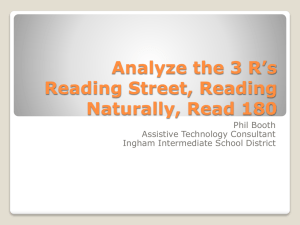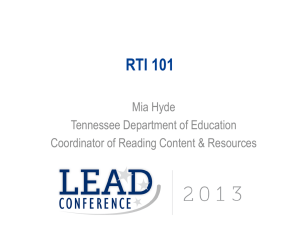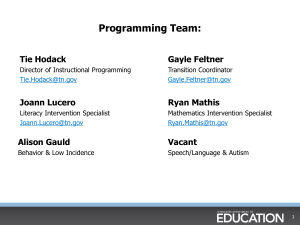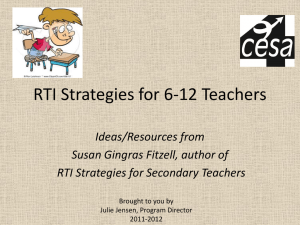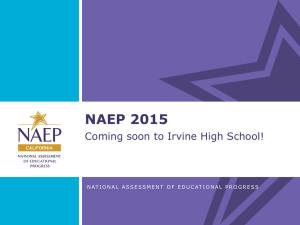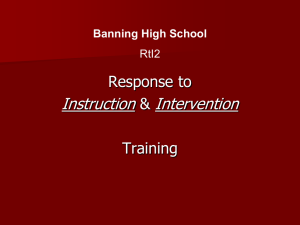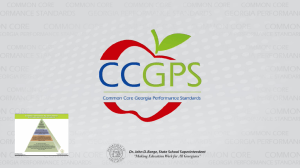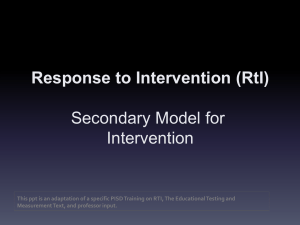Slide 0 - TN Core
advertisement
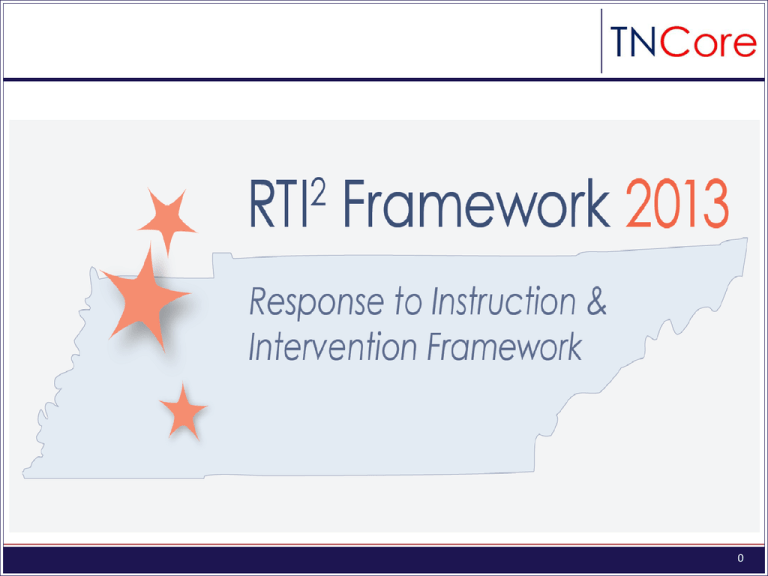
0 What is Response to Intervention: •Response to Intervention is NOT: • Just a Special Education initiative • Only for students with disabilities • Only for beginning reading • Only for non-Title 1 and non-ESL students • A new way to identify students with SLD • A way of reducing costs or eliminating special education or the LD category • This year’s summer reform or a short-term implementation based on “RTI in a Box” • A way to fix schools with weak core instruction • Source: Fletcher, Jack (2013) Classifications and Definitions for the Identification of Learning Disabilities: An Evaluation of the Research. Presentation for RTI²: A School Psychologist’s Guide to Implementation. Murfreesboro, TN. 1 Response to Intervention Is: • A set of processes for coordinating high quality service delivery in schools • A multi-tiered, layered instructional approach that prevents problems first, and then brings increasingly intense interventions to students who don’t respond • Making instructional decisions based on data • Integrating entitlement programs with general education • Providing relevant data for SLD identification • Primary goal: Improving academic (and behavioral) outcomes for all students by eliminating discrepancies between actual and expected performance. • Source: Fletcher, Jack (2013) Classifications and Definitions for the Identification of Learning Disabilities: An Evaluation of the Research. Presentation for RTI²: A School Psychologist’s Guide to Implementation. Murfreesboro, TN. 2 Our transition to Common Core Standards is central to strengthening Tennessee’s competitiveness Only 21% of adults in TN have a college degree TN ranks 46th in 4th grade math and 41st in 4th grade reading nationally Tennessee’s Competitiveness 54% of new jobs will require postsecondary education Only 16% of high school seniors in TN are college ready Source: “Projections of Jobs and Education Requirements Through 2018” (The Georgetown University Center on Education and the Workforce), 2011 NCES NAEP data, ACT 3 NAEP Performance Levels for Reading and Math All Students 4th Grade NAEP Math 50% 40% 29.8 31.7 31.5 32.4 30% 20% 26.7 28.0 26.9 10% 2005 Tennessee 2007 2009 50% 40% 35.3 20% 27.7 39.7 28.7 28.4 29.5 0% 2005 2011 National public Tennessee Year 2007 2009 2011 8th Grade NAEP Reading NAEP Math 50% 40% 28.9 29.2 26.2 25.6 30.4 31.6 30% 10% 27.9 27.0 National Public Tennessee Year 0% 2005 2007 2009 2011 Percent Proficient 50% Percent Proficient 38.4 30% 8th Grade 20% 38.6 10% National public Year 0% 25.8 Percent Proficient Percent Proficient 4th Grade NAEP Reading 40% 30% 28.5 20% 20.6 31.0 23.1 32.6 33.5 25.2 23.9 10% Year 0% 2005 2007 National public Tennessee 2009 2011 Source: NAEP Data Explorer Note: Southern states included are Alabama, Florida, Georgia, Kentucky, Mississippi, North Carolina, South Carolina, Virginia, and West Virginia. 4 5 Areas of Deficit •Basic Reading Skills (letters, letter sounds, decode) •Reading Comprehension •Reading fluency •Written expression •Math calculation •Math reasoning (problem solving) 6 At All Tiers •District and school teams •Universal Screener •Assessments (ongoing and progress monitoring) •Recommended Instructional Time •Fidelity Monitoring •Parent involvement •Professional Development 7 8 9 Tier I - Instruction • Classroom instruction for all - Common Core State Standards • Research shows 80-85% of students will respond to Tier I • Recommended Instructional Time – ELA: K-2/150 min; 3-5/90 min; 6-12/55 traditional 90 block – Math: K-1/60 min; 2/75min; 3-5/90 min; 6-12/55 traditional 90 block • Ongoing Assessments (grade level checks, benchmarks) – Collect data points, determine patterns, track individuals and groups, – Guide instruction (teach/assess/monitor/adjust) • Fidelity Monitoring (Team, Student Data, etc…) • Universal Screener (K-8, recommended 9-12)(students below 25% go to Tier II) 10 11 Tier II - Intervention •High quality research based intervention in specific area of deficit (standards protocol or problem solving or hybrid of 2) •Research shows 10-15% will need Tier II •30 minutes of explicit instruction daily, small groups •Universal Screener (K-8, recommended 9-12)(Based on national norms) •Survey-Level assessment (process to determine the basic skill area of deficit) 12 Tier II - Intervention •Progress Monitor (every 1-2 weeks in area of deficit) –Collect data points, determine patterns, track individuals •Fidelity Monitoring (3 times a marking period, at least 2 direct observation) •Rate of Improvement •Taught by highly trained personnel 13 14 Tier III - Intervention •High quality research based intervention in specific area of deficit (the most intensive intervention possible) •Research shows 3-5% will need Tier III •45-60 minutes of explicit instruction daily, small groups •Universal Screener (K-8, recommended 9-12)(Based on national norms) •Survey-Level assessment (process to determine the basic skill area of deficit) 15 Tier III - Intervention •Progress Monitor (every 1-2 weeks in area of deficit) –Collect data points, determine patterns, track individuals •Fidelity Monitoring – 5 times a marking period – 3 direct observation (at least) – 2 must be a review of implementation data (student attendance, lesson plans, progress monitoring results •Rate of Improvement •Taught by highly trained personnel 16 •Tier III Replacement Decisions/Special Education 17 Response to Instruction & Intervention Implementation Guide • More details on each Tier • Scheduling samples • Rubric for universal screeners and interventions • Scenarios • Parent letters and communication samples • Students entering mid-term • ELL guidance 18 Tncore.org RTI.questions@tn.gov 19 Members of the Reading & RTI Leadership Council: Cindy Ables, ELA Coordinator, Lincoln County Schools Susan Dold, Elementary ELA Supervisor, Memphis City Schools Nancy Duggin, Consultant Marianne Gilbert, K-5 Literacy Supervisor, Williamson County Schools Stacy King, Common Core Specialist, Greeneville City Schools Sherry Roberson, Special Education Supervisor, Putnam County Schools Janet Sexton, Elementary Reading Supervisor, Knox County Schools Sherry Shroyer, Principal, Bradley County Schools STRATEGIC PLAN
